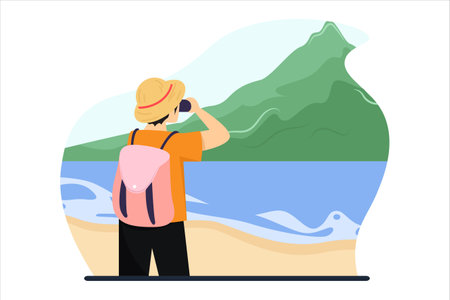Introduction to Andaman & Nicobar Trek Experience
Namaste dosto! If your heart beats for adventure and your soul seeks the thrill of the unknown, then trekking through the Andaman & Nicobar Islands is a must on your bucket list. Nestled in the Bay of Bengal, these islands are India’s very own emerald paradise, brimming with untamed jungles, cascading waterfalls, and untouched beaches that will leave you saying “Wah bhai wah!” From the lush mangroves to dense tropical forests, Andaman & Nicobar boast a biodiversity that’s as colourful as our Indian festivals—home to rare flora and fauna you won’t spot anywhere else in the desh. But what truly sets these islands apart is their deep-rooted connection to ancient tribal cultures, with communities like the Jarawas and Sentinalese preserving traditions that go back thousands of years. Trekking here isn’t just about chasing waterfalls or walking sandy shores; it’s about immersing yourself in a unique blend of natural grandeur and cultural heritage that adds real masala to your journey. Get ready for an experience where every footstep tells a story—from colonial history to indigenous wisdom—and every waterfall welcomes you with open arms. So tighten your backpack straps, lace up those sturdy shoes, and let’s set off on this desi-style trek where India’s wild beauty meets its soulful legacy.
2. Gearing Up: Essentials for Waterfall Trekking
Before you set off to explore the majestic waterfalls of the Andaman and Nicobar Islands, proper preparation is key to a safe and enjoyable trek. The region’s tropical climate, lush forests, and rugged terrains demand specialized gear. Here’s your detailed packing guide, blending modern trekking know-how with local wisdom straight from Port Blair markets.
Packing Checklist: Must-Have Trekking Gear
| Item | Purpose | Local Tips |
|---|---|---|
| Trekking Shoes | Grip on slippery rocks and muddy paths | Lightweight options available at Aberdeen Bazaar |
| Waterproof Backpack | Keeps belongings dry during monsoon showers | Look for rain covers in outdoor shops near Clock Tower Market |
| Reusable Water Bottle | Stay hydrated in humid conditions | Copper bottles popular among locals for cool water |
| Headlamp or Torch | Essential for early morning or dusk treks | Batteries easily found in Port Blair markets |
| First Aid Kit | Treat minor cuts, insect bites, or sprains | Add Dettol and herbal balms sold by local vendors |
Clothing: Dressing for Humidity & Terrain
- Opt for lightweight, quick-dry t-shirts and trekking pants. Avoid jeans as they retain moisture.
- A poncho or rain jacket is a must during sudden downpours—choose bright colours to stay visible in thick foliage.
- Packed bandanas or caps protect against sunstroke while trekking open stretches.
Sourcing Local Snacks: Fuel Like an Islander
No trek in India is complete without energizing snacks. In Andaman, banana chips (kela chips), roasted peanuts (mungphali), and sweet coconut candy are favourites. Local street stalls around Port Blair’s Junglighat Market offer these snacks fresh and affordable. For hydration, sip on tender coconut water (nariyal paani) from roadside vendors—it’s the island way!
Pro Tip: Shopping at Port Blair Markets
- Aberdeen Bazaar: Best for basic trekking gear, hats, sunglasses, and locally made snacks.
- Dairy Farm Road Market: Source fresh fruits like guavas and pineapples for natural energy boosts.
Prepare wisely using this gear and snack guide, and you’ll be ready to embrace the wild beauty of the Andaman Nicobar waterfalls like a true adventurer—and perhaps, feel a bit like a local too!

3. Journey into Tribal Heartlands
Exploring the Andaman and Nicobar Islands is not just about turquoise beaches and cascading waterfalls—it is also an immersion into the vibrant tapestry of indigenous cultures. Trekking through these islands, you may encounter the Nicobarese and Jarawa communities, whose presence adds a unique depth to your adventure.
Understanding Tribal Communities
The Nicobarese are predominantly settled in the Nicobar Islands, known for their communal spirit, traditional stilt houses, and intricate handicrafts. The Jarawa, on the other hand, are among the original inhabitants of the Andaman Islands, maintaining a semi-nomadic lifestyle within protected reserves. These communities have thrived by living in harmony with nature—a lesson every trekker can appreciate.
Customs and Cultural Sensitivities
When journeying near tribal areas, it’s crucial to approach with humility and respect. Always remember that many tribes—especially the Jarawa—prefer minimal outside contact. Photography or direct engagement without permission is strictly discouraged by local laws and can deeply offend community members. Instead, observe from a respectful distance and cherish the opportunity to witness their time-honoured ways of life.
Tips for Respectful Engagement
- Always seek guidance from authorized local guides before entering any tribal territory.
- Do not attempt to offer gifts, food, or money; this disrupts traditional practices and is considered disrespectful.
- Dress modestly—cover arms and legs—to align with local sensibilities.
- Avoid loud noises or sudden movements that might disturb daily routines.
Engaging respectfully ensures both your safety and the dignity of these ancient cultures. Remember, government regulations are strict: interactions with certain tribes like the Jarawa are legally restricted to protect their privacy and health. By following these cultural dos and don’ts, you contribute positively to preserving the islands’ delicate social fabric while gaining authentic insight into India’s most enigmatic communities.
4. Chasing Waterfalls: Top Trails & Hidden Gems
If you are dreaming of the perfect monsoon escape, Andaman and Nicobar’s waterfalls deliver both thrill and tranquility. From the roaring White Surf to the melodious Whisper Wave, each trek is a blend of adventure, local tribal legends, and those picture-perfect moments every desi traveller craves. Whether you’re a solo backpacker or coming with your travel squad, these trails promise memories for a lifetime—and some epic Insta reels.
Spotlight Waterfall Treks
| Waterfall | Trail Difficulty | Distance | Local Guide Tips |
|---|---|---|---|
| White Surf Waterfall (Little Andaman) | Moderate | 2.5 km one way | Carry ORS; best visited post-monsoon for full flow; avoid slippery rocks. |
| Whisper Wave Waterfall (Middle Andaman) | Difficult | 5 km one way | Hire a local guide from Rangat; start early to spot rare birds and butterflies. |
White Surf Waterfall Trail: Desi Backpackers’ Delight
This trail is a crowd favourite among Indian trekkers and Insta bloggers alike. The path cuts through dense rainforest—a true “jungle mein mangal” experience! Locals often narrate stories of tribal children racing up the rocks barefoot, making us city folks look like total noobs. Don’t miss out on cooling your feet in the plunge pool at the end; it’s a proper “chill maar” moment after the humid trek.
Whisper Wave Waterfall: Where Legends Flow
This trek is not for the faint-hearted. Winding through thick bamboo groves and slippery slopes, this trail is best tackled with an experienced guide—many of whom belong to indigenous communities and know every shortcut and story. Past trekkers rave about spotting rare orchids along the way and sharing pakoras with fellow hikers by the water’s edge. Pro tip: Carry extra phone battery for those epic group selfies!
Previous Trekkers’ Fun Stories
- A Delhi group once celebrated a birthday at White Surf, complete with homemade laddoos—talk about “waterfall wali party!”
- Bengaluru techies on a digital detox found themselves teaching local kids cricket at Whisper Wave village basecamp.
No matter which trail you pick, remember: respect nature, listen to your guide, and always keep that camera ready. The real “Andaman wala swag” is all about blending adventure with local culture!
5. Sea Bliss: Cooling Off and Local Seaside Experiences
Post-Trek Dip: Refresh and Recharge
After trekking through the lush jungles and misty waterfalls of Andaman and Nicobar, nothing beats the feeling of slipping into the cool, clear waters of the Bay of Bengal. Popular among Indian backpackers, Radhanagar Beach on Havelock Island is a favourite spot to relax your legs after a challenging hike. The gentle waves offer a soothing embrace, while the soft sand invites you to simply unwind. For those seeking more privacy, hidden coves near Kalapathar or Chidiya Tapu provide a quieter retreat to soak in the sea’s rejuvenating vibes.
Seaside Shacks: Coconut Water & Chai Time
No beach day in India is complete without sipping on nariyal pani (coconut water) from a local seaside shack. On Neil Island, shacks like “Bhaiya’s Nariyal Stand” are well-known for their chilled coconuts and friendly banter. If you’re craving something warm post-swim, try a cup of masala chai with bhajiyas at small stalls lining the beaches—these spots often become impromptu meeting points for travellers sharing stories from their treks.
Fresh Seafood With a View
The islands are a paradise for seafood lovers. After your waterfall adventure, dig into plates of tawa-fried fish or prawn curry with steaming rice at local dhabas along Corbyn’s Cove or Sitapur Beach. Sunset Beach Cafe on Havelock is especially popular for its grilled catch-of-the-day and panoramic sunset views—a must-visit hangout for desi backpackers looking to end their trek-filled day on a high note.
Local Hangouts & Sunset Points
For that perfect golden hour moment, join fellow travellers at Laxmanpur Beach on Neil Island or Wandoor Beach near Port Blair. These spots are renowned for their vibrant sunsets and relaxed atmosphere—ideal places to swap trek tips, click groupfies, and enjoy pakoras as the sky turns orange and pink. Don’t forget to carry your own reusable bottle; most shacks will happily refill it with filtered water, in true Indian eco-traveller spirit.
Pro Tips From Seasoned Backpackers
Arrive early at seaside shacks during weekends to grab a seat with the best view. Always ask locals about today’s fresh catch before ordering seafood—it’s the surest way to enjoy authentic island flavours! And remember, dipping in the sea after a jungle trek isn’t just about cooling off; it’s about living the full Andaman experience—where nature, food, and culture blend seamlessly along every shoreline.
6. Ethical Trekking & Responsible Travel
Respecting the Soul of Andaman Nicobar
Trekking through the untouched trails and lush forests to reach Andaman Nicobar’s majestic waterfalls is not just an adventure—it’s a responsibility. The islands are home to ancient tribal communities, rare wildlife, and delicate ecosystems that demand mindful exploration. Being a responsible traveler means understanding your actions can impact both nature and culture in ways you might not expect.
Eco-Friendly Practices: Walk Light, Leave No Trace
Carry back every bit of waste—plastic, wrappers, bottles—nothing should be left behind. Use reusable water bottles and cloth bags (jholas) instead of single-use plastics. Stick to marked trails; off-path wandering may damage fragile flora or disturb local wildlife. Remember, your footprints should be the only thing you leave behind on these islands. If you need to answer nature’s call, dig a small pit away from water sources and cover it well—this is true ‘desi jugaad’ for trekking etiquette!
Respect for Tribal Cultures: Humility is Key
The indigenous tribes of Andaman Nicobar have deep-rooted traditions and often prefer minimal interaction with outsiders. Respect their privacy—do not take photographs without permission or try to intrude into their settlements. Always seek guidance from certified local guides who understand the cultural nuances. Buying locally made handicrafts or food directly supports the community without exploitation.
Desi Dos & Don’ts for Island Trekking
- Do: Greet locals with a smile and simple “Namaste” or “Vanakkam”—it goes a long way.
- Do: Carry eco-friendly gear: bamboo toothbrushes, biodegradable soaps, solar chargers.
- Don’t: Use loudspeakers or play music—nature’s silence is sacred here.
- Don’t: Pick flowers, shells, or corals; let natural treasures stay where they belong.
Your journey across waterfalls and tribal villages is about blending in, not standing out. By adopting these simple yet powerful practices, you ensure that Andaman Nicobar’s beauty remains unspoiled for generations—making your trek truly meaningful, desi style!
7. Takeaways and Personal Reflections
Wrapping up the epic trek through the waterfalls of Andaman and Nicobar, I find myself sitting by the shimmering blue waters, chai in hand, heart brimming with gratitude and memories. Each step through the dense emerald forests brought new discoveries—not just of hidden streams and cascading falls, but also of myself and my trekking buddies from across India. From sharing stories in Hindi to laughing over spicy Maggi noodles under the stars, our bond grew stronger with every kilometre. The chance to learn about the ancient tribal cultures, witness their art, and hear their songs was truly humbling. I realised that Andaman is not just about beaches—it’s a living tapestry of traditions and untouched natural beauty.
Exploring these unexplored corners with my desi trekking gang made the adventure all the more special. Our boots got muddy, our spirits soared, and our cameras struggled to capture the sheer magic of those moments. There were times we felt lost in the wilderness, but together we found new trails—and new versions of ourselves.
To my fellow travellers dreaming of an offbeat experience: don’t just stick to Port Blair or Havelock. Venture into the unknown! Respect local customs, travel light, pack your reusable bottles, and keep your hearts open for surprises—nature will reward you tenfold. The Andamans have so many stories left untold; it’s up to us to discover them responsibly.
If you are reading this with itchy feet and wanderlust in your soul—#ChaloAndaman! Your next great Indian adventure awaits amidst these mystical islands. Come for the sea bliss, stay for the soulful connections and the thrill of discovery. I promise—this trek will become a memory you will cherish forever.


